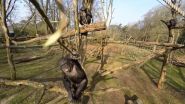Each year, approximately one million children under the age of four undergo surgery with general anesthesia, according to the U.S. Food and Drug Administration (FDA). Retrospective birth-cohort studies of children have found an association between learning problems and multiple exposures to anesthesia early in life, and research in animal models, mainly rodents, has shown that early anesthesia exposure causes cell death in the brain and cognitive impairments later in life.
Nevertheless, uncertainty remains about the extent to which anesthesia specifically may be a risk factor in humans, when compared to other factors and co-morbidities associated with anesthesia and surgery. Additionally, the applicability of rodent studies to humans has been questioned on a number of grounds, including a lack of correspondence of developmental stages between the species.
The Mount Sinai/Yerkes study is the first to address the question of whether repeated postnatal anesthesia exposure, in and of itself, caused long-term behavioral changes in a highly translationally relevant rhesus monkey model. The stage of neurodevelopment of rhesus monkeys at birth is more similar to that of human infants compared to neonatal rodents; with respect to brain growth, a six-week-old rhesus monkey corresponds to a human in the second half of his or her first year of life. Because these kinds of controlled studies cannot be carried out in humans, it is essential to use a comparable animal model to discover if anesthesia may be affecting the brain. Unlike previous research, the study was conducted in the absence of a surgical procedure, co-morbidities that may necessitate surgical intervention or the psychological stress associated with illness.
"The major strength of this study is its ability to separate anesthesia exposure from surgical procedures, which is a potential complication in the studies conducted in children," says Mark Baxter, PhD, professor in the Departments of Neuroscience and Anesthesiology at the Icahn School of Medicine at Mount Sinai. "Our results confirm that multiple anesthesia exposures alone result in emotional behavior changes in a highly translational animal model. This raises concerns about whether similar phenomena are occurring during clinical anesthesia exposure in children."
Specifically, the study team exposed 10 nonhuman primates (rhesus monkeys) to a common pediatric anesthetic called sevoflurane for a comparable length of time required for a significant surgical procedure in humans (four hours). They were exposed to the anesthetic at postnatal day seven and then again two and four weeks later, because human data indicate that repeated anesthesia results in a greater risk of learning disabilities relative to a single anesthetic exposure.
Researchers evaluated the socioemotional behavior of exposed subjects compared with that of healthy controls at six months of age using a mild social stressor (an unfamiliar human). They found the anesthesia-exposed infants expressed significantly more anxious behaviors overall compared with controls.
"The task we used is designed to be similar to the task used for assessing dispositional anxiety and behavioral inhibition in children, thus increasing the study's applicability to humans," says first author Jessica Raper, PhD, research associate in the Division of Developmental and Cognitive Neuroscience at Yerkes National Primate Research Center at Emory University, where the testing was conducted. The study results also demonstrate that alterations in emotional behavior persist at least five months after anesthesia exposure, suggesting long-term effects.
Co-investigator Maria Alvarado, PhD, also of the Yerkes Research Center adds, "Events that impact the developing brain have the potential to affect a wide range of later-developing behaviors."
These findings are part of a larger longitudinal study, and researchers at the Icahn School of Medicine at Mount Sinai and the Yerkes National Primate Research Center will continue to follow these study subjects behaviorally to fully characterize the length of time that these emotional changes persist and whether they resolve over time.
Considering that most pediatric surgeries are non-elective, future studies can use this primate model to develop a new anesthetic agent or prophylactic treatment to counteract the impact of anesthesia on behavior in children. The findings also suggest that additional work is required to identify the mechanisms by which anesthetics may cause long-term changes in central nervous system function that impact behavior.
INFORMATION:
The National Institute of Child Health and Human Development and the National Institutes of Health Office of the Director, Office of Research Infrastructure Programs, supported this research.
SmartTots, a partnership between the International Anesthesia Research Society (IARS) and the FDA, is another resource for more information on the safe use of anesthetics in pediatric patients.
About the Mount Sinai Health System
The Mount Sinai Health System is an integrated health system committed to providing distinguished care, conducting transformative research, and advancing biomedical education. Structured around seven hospital campuses and a single medical school, the Health System has an extensive ambulatory network and a range of inpatient and outpatient services--.from community-based facilities to tertiary and quaternary care.
The System includes approximately 6,100 primary and specialty care physicians; 12 minority-owned free-standing ambulatory surgery centers; more than 140 ambulatory practices throughout the five boroughs of New York City, Westchester, Long Island, and Florida; and 31 affiliated community health centers. Physicians are affiliated with the renowned Icahn School of Medicine at Mount Sinai, which is ranked among the highest in the nation in National Institutes of Health funding per investigator. Seven departments at The Mount Sinai Hospital and one at the New York Eye and Ear Infirmary (NYEE) ranked nationally in the top 25 in the 2015-2016 "Best Hospitals" issue of U.S. News & World Report. Mount Sinai's Kravis Children's Hospital also is ranked in seven out of ten pediatric specialties by U.S. News & World Report.
For more information, visit http://www.mountsinaihealth.org/ or find Mount Sinai on Facebook, Twitter and YouTube.
